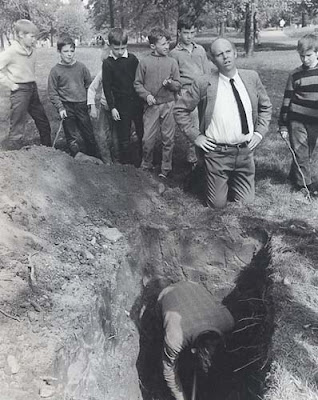earthworks art movement, fittingly titled Earthworks, with Claes Oldenburg's piece the Hole. Oldenburg best known as a progressive leader in the pop art movement organized an excavation, adhering to the dimensions of a human grave, in Central Park on October 1, 1967. Entitled Placid Civic Monument, but referred to as the Hole or Burial Monument by Oldenburg in his notes, was part of an exhibition sponsored by the NYC Administration of Recreation and Cultural Affairs.
Oldenburg termed his recession in the ground of Central Park as an "invisible monument". The negative space created by the removal of topsoil is similar to Carl Andre's exploration of "holes" in his 1967 show at the Dwan Gallery. Boettger notes that while Oldenburg was not an earthworks artist, the element of "nonvisisbility,transience or geographical remoteness is another aspect aligned to practices fundamental to Earthworks".
3 weeks prior to the "excavation" similar ideas were explored in the exhibition 19:45-21:55 in Germany. 19:45-21:55 reference a twenty four hour time period was arranged by Paul Manez a curator and art director. 19/21 was an exhibition of "anti form" and included work from the artists Jan Dibbets,Richard Long, Barry Flanagan and John Johnson. The latter three sending boxes of organic materials with a list of instructions(some including additional collecting of materials), "in this way binding the gallery's interior to a reference of the natural environment".
The parallels between the the American and European earth works and post minimalism were unknown in the late sixties US. Boetteger connects the two using the Oldenburg's "Hole" because it corresponds to the early use of natural materials in art works in the US. and abroad.
These early earthworks were a response to a new understanding and awareness of the ecological environment as well the the socio-politcal unrest that characterized the Sixties. The idea of the work evolving due to natural forces or human interaction was key.
The "Hole" was interpreted and referenced to as a "grave for dead art", "a wounded virgin" and "and a trench", among many others. But what existed to the public was open grave.
As stated Oldenburg:
"By not burying a thing the dirt enters into the concept, and little enough separates the dirt inside the excavation from that outside..so that the whole park and its connections, in turn enter into it. Which meant that my event is merely the focus for me of what is sense, or in the corner of a larger field.."
Chapter 1 Response

Had a lecture about this at school today but unfortunately my prof did not do her research and could not tell us what the point of the hole was. Thanks for the enlightenment!
ReplyDeleteYou might have a bit more respect for your prof, she's doing well to even introduce you to this work, and she must be doing something right in order for you to be suffiently interested to look it up here. Don't expect the world to be handed over on a plate, professers are squeezed by the system and could do with encouragement from their pupils. Well done for your research though!
ReplyDeleteYou might have a bit more respect for your prof, she's doing well to even introduce you to this work, and she must be doing something right in order for you to be suffiently interested to look it up here. Don't expect the world to be handed over on a plate, professers are squeezed by the system and could do with encouragement from their pupils. Well done for your research though!
ReplyDeleteDamn couldn't have said it better myself
Delete